
Carmichaelia is a genus of 24 plant species belonging to Fabaceae, the legume family. All but one species are native to New Zealand; the exception, Carmichaelia exsul, is native to Lord Howe Island and presumably dispersed there from New Zealand.

Clianthus, commonly known as kakabeak, is a genus of flowering plants in the legume family Fabaceae, comprising two species of shrubs endemic to the North Island of New Zealand. They have striking clusters of red flowers which resemble the beak of the kākā, a New Zealand parrot. The plants are also known as parrot's beak, parrot's bill and lobster claw – all references to the distinctive flowers. There is also a variety with white to creamy coloured flowers called: "Albus," and a variety with rosy pink flowers called: "Roseus."

Clianthus puniceus, common name kaka beak, is a species of flowering plant in the genus Clianthus of the legume family Fabaceae, native to New Zealand's North Island.

Carmichaelia carmichaeliae is a species of plant in the family Fabaceae. It is found only in South Island of New Zealand. It is classified as having the "Nationally Critical" conservation status under the New Zealand Threat Classification System.

Carmichaelia glabrescens is a species of plant in the family Fabaceae. It is found only in New Zealand.

Carmichaelia torulosa is a species of plant in the family Fabaceae. It is found only in New Zealand.

Galegeae is a tribe in the flowering plant family Fabaceae, subfamily Faboideae. The tribe is found mostly in the northern hemisphere, but can also be found in Australia, Africa, and South America. Recent molecular phylogenetic work has determined that tribe Galegeae is paraphyletic, and that its members are scattered throughout the IR-lacking clade.
The New Zealand Threat Classification System is used by the Department of Conservation to assess conservation priorities of species in New Zealand.

Clianthus maximus, commonly known as kaka beak, is a woody legume shrub native to New Zealand's North Island. It is one of two species of Clianthus and both have striking clusters of red flowers which resemble the beak of the kaka, a New Zealand parrot.
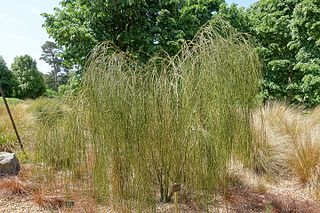
Carmichaelia stevensonii, the cord broom or weeping broom, is a species of plant in the family Fabaceae. It is found only in the north east of the South Island of New Zealand. It is threatened by habitat loss.

Carmichaelia muritai, common name coastal tree broom, is a species of plant in the family Fabaceae. It is found only in the South Island of New Zealand.

Montigena is a genus of flowering plant in the legume family Fabaceae. It includes the sole species Montigena novae-zelandiae, known more commonly the scree pea, a dicotyledonous herb endemic to the South Island of New Zealand. The plant is small and woody, arising from thin, branched stems that extend to the surface from a deeply buried root stock. The flowers vary from purple to brown, while fruits appear between January and April.
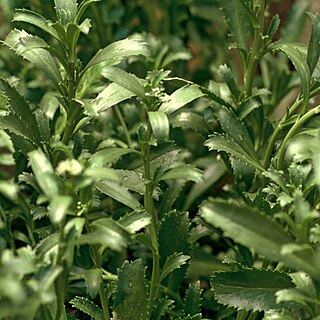
Lepidium banksii, known as coastal peppercress, is a rare species of flowering plant from the family Brassicaceae. It is endemic to New Zealand, formerly found around the coast of the northern South Island but now critically endangered.
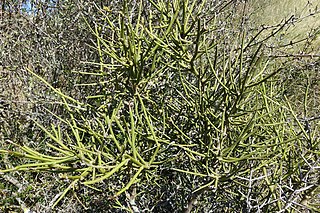
Carmichaelia petriei is a species of New Zealand broom in the genus Carmichaelia. It is endemic to New Zealand. C. petrieis is possibly a host plant for the critically endangered fungus weevil Cerius otagensis.

Dysphania pusilla, formerly Chenopodium pusillum, otherwise known as pygmy goosefoot or parahia in Māori, is a prostrate herb endemic to the north-eastern parts of South Island, New Zealand. Presumed extinct after 56 years without recorded observations, the species was rediscovered in 2015.
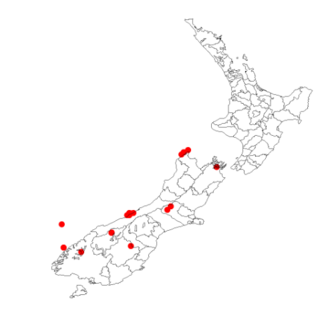
Carmichaelia juncea, the braided riverbed broom, is a species of New Zealand broom, a prostrate shrub in the family Fabaceae that is endemic to New Zealand. It is extinct over much of its former range, including the North Island.

Carmichaelia curta is a species of plant in the family Fabaceae. It is found in New Zealand. It is classified as having the "Nationally Critical" conservation status under the New Zealand Threat Classification System.

Alternanthera nahui, common name nahui, is a species in the family Amaranthaceae, native to New Zealand and to Norfolk Island.
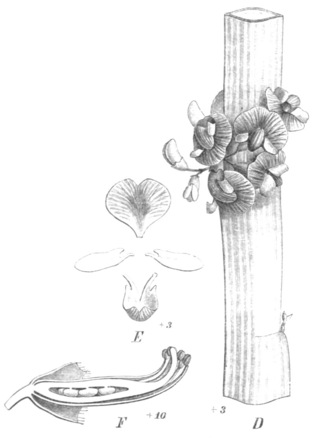
Carmichaelia australis, commonly known as the New Zealand common broom or mākaka, is a shrub of the Fabaceae family. It is native to New Zealand and found in both the North and South Islands.
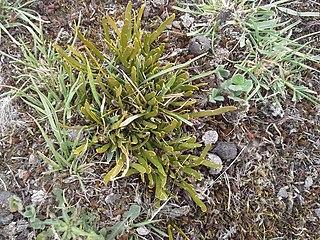
Carmichaelia corrugata is a species of plant in the family Fabaceae. It is found only on the South Island of New Zealand.


















